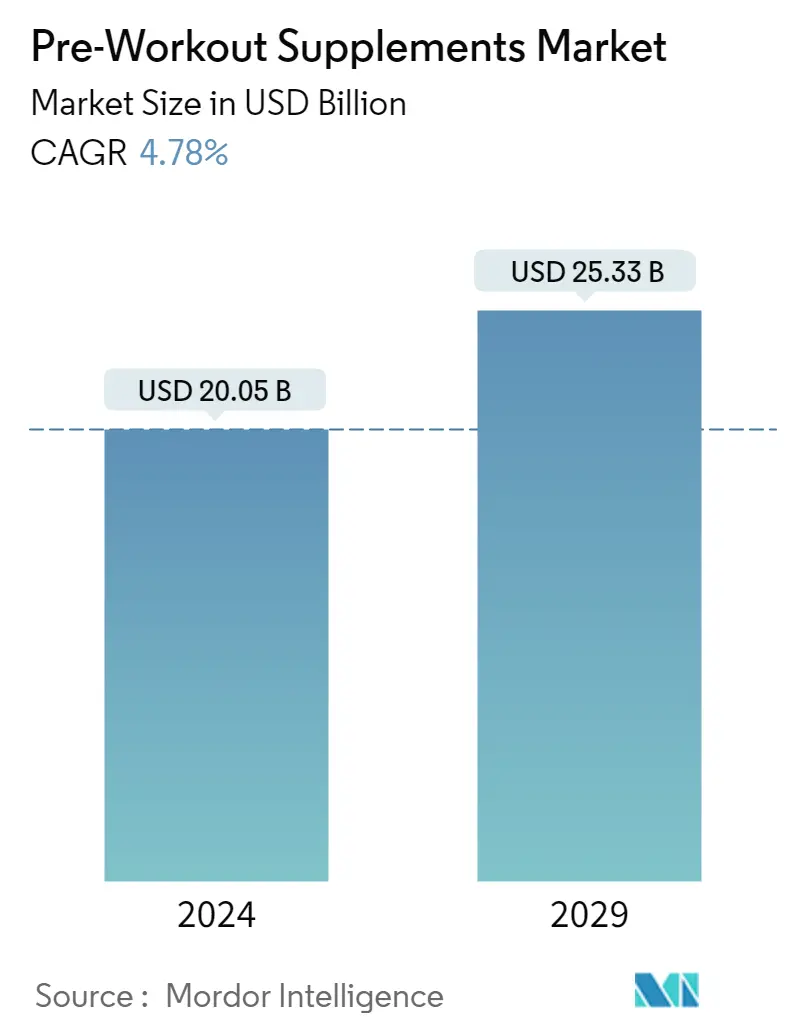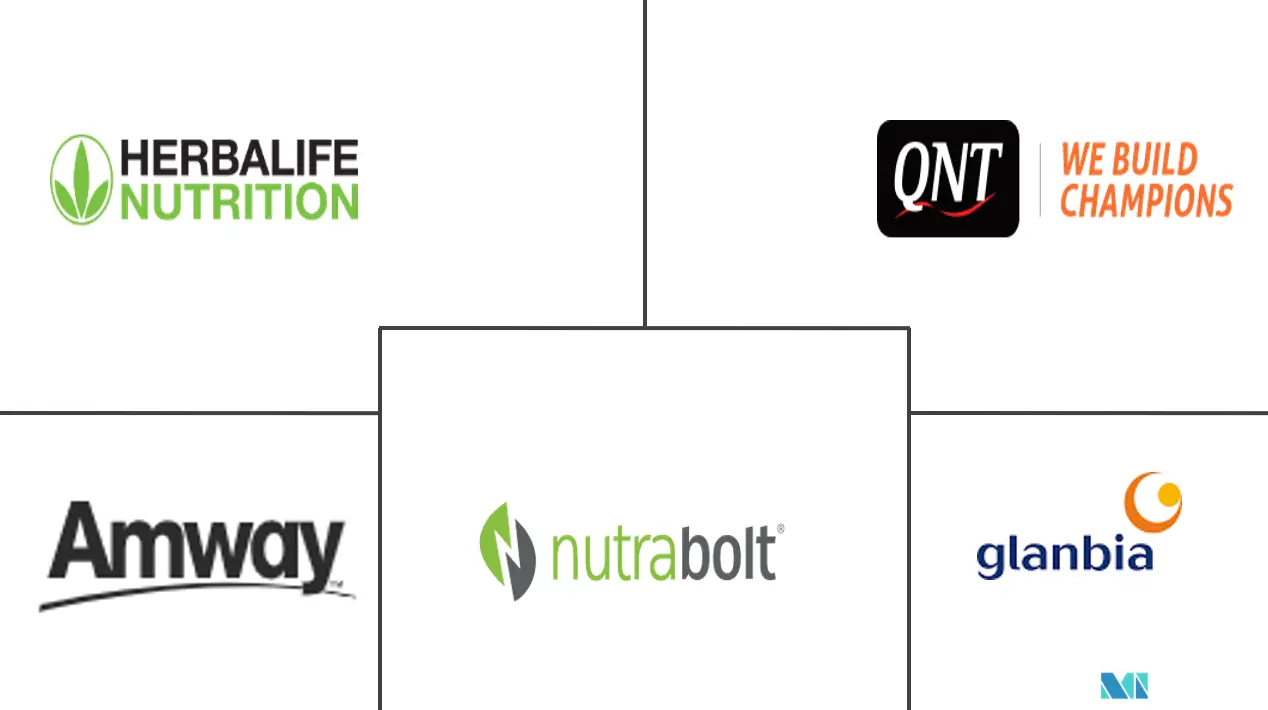Market Size of Pre-Workout Supplements Industry

| Study Period | 2019 - 2029 |
| Market Size (2024) | USD 20.05 Billion |
| Market Size (2029) | USD 25.33 Billion |
| CAGR (2024 - 2029) | 4.78 % |
| Fastest Growing Market | Asia-Pacific |
| Largest Market | North America |
Major Players
*Disclaimer: Major Players sorted in no particular order |
Pre-Workout Supplements Market Analysis
The Pre-Workout Supplements Market size is estimated at USD 20.05 billion in 2024, and is expected to reach USD 25.33 billion by 2029, growing at a CAGR of 4.78% during the forecast period (2024-2029).
The government imposed lockdowns as a result of the COVID-19 pandemic, which led to a growing number of consumers taking up exercise routines at home to stay physically fit. This factor resulted in a growing demand for nutritional products to enhance performance, coupled with growing awareness among consumers of the need for workout supplements, which drove the demand for pre-workout supplements. Consumers are performing different practices, such as exercise, yoga, and gym, that lead to a healthy lifestyle. These practices have increased the demand for health-related products like organic food, sports equipment, and pre-workout supplements in order to increase strength while working out. Expanding the significance of a dynamic way of life and developing mindfulness with respect to the advantages of proteins has led to the rise of pre-workout supplements. Pre-workout supplements come in a variety of forms, but powder form is the most preferred among consumers. Powdered pre-workout supplements are more popular because they're easy to consume. It has been observed that most end users prefer the powdered form because it offers a more concentrated dose of the active ingredients.
Major consumers of pre-workout supplements include athletes and bodybuilders. However, the consumption of pre-workout supplements has been consistently rising among casual users for recreational and lifestyle purposes, owing to increased health awareness and rising disposable income among consumers. Some manufacturers are also introducing clean-label products to attract consumers. In April 2022, GNC launched Pre-JYM X Pre-Workout for high-performing fitness enthusiasts and athletes.
However, the lack of proper regulatory frameworks in emerging economies and the lack of awareness about side effects are projected to restrain the market's growth potential over the forecast period.
Pre-Workout Supplements Industry Segmentation
Pre-workout supplements are supplement products that give energy during exercise. Pre-workout is a dietary enhancement utilized by competitors and weightlifters to improve athletic performance. It is taken to build continuity, vitality, and a center during a workout. The global pre-workout supplements market is segmented by type, distribution channel, and geography. The market is segmented by type: powder, capsules or tablets, drinks, and other types. Based on distribution channels, the market studied is segmented by supermarkets and hypermarkets, specialty stores, online retail stores, and other distribution channels. The study also analyzes the pre-workout supplement market in emerging and established markets worldwide, including North America, Europe, Asia-Pacific, South America, and the Middle East and Africa. For each segment, the market sizing and forecasts have been done on the basis of value (in USD million).
| Type | |
| Powder | |
| Capsule/ Tablet | |
| Drinks | |
| Other Types |
| Distribution Channel | |
| Hypermarket/Supermarket | |
| Specialty Stores | |
| Online Retail Stores | |
| Other Distribution Channels |
| Geography | |||||||||
| |||||||||
| |||||||||
| |||||||||
| |||||||||
|
Pre-Workout Supplements Market Size Summary
The pre-workout supplements market is experiencing significant growth, driven by increasing consumer awareness of health and fitness benefits. The demand for these supplements has been bolstered by the rise in home workouts during the COVID-19 pandemic, leading to a greater emphasis on nutritional products that enhance exercise performance. Consumers are increasingly engaging in activities such as yoga, gym workouts, and other fitness regimes, which has spurred the demand for health-related products, including pre-workout supplements. The market is characterized by a preference for powdered supplements due to their ease of consumption and concentrated active ingredients. While athletes and bodybuilders remain primary consumers, there is a notable rise in casual users seeking recreational and lifestyle benefits, supported by rising disposable incomes and health consciousness.
The market's expansion is further fueled by the growing number of fitness centers and the increasing popularity of ready-to-drink supplements. However, challenges such as inadequate regulatory frameworks in emerging economies and limited awareness of potential side effects may hinder growth. The Asia-Pacific region is witnessing rapid market development, driven by changing consumer preferences for healthy foods and lifestyles. The proliferation of health clubs and fitness centers in countries like China and India is creating robust distribution channels for pre-workout products. Major players in the market are focusing on product innovation, strategic partnerships, and geographical expansion to strengthen their market presence. This competitive landscape is marked by collaborations and new product launches, aiming to cater to the evolving consumer demands for energy-boosting nutritional products.
Pre-Workout Supplements Market Size - Table of Contents
-
1. MARKET DYNAMICS
-
1.1 Market Drivers
-
1.2 Market Restraints
-
1.3 Industry Attractiveness - Porter's Five Forces Analysis
-
1.3.1 Threat of New Entrants
-
1.3.2 Bargaining Power of Buyers/Consumers
-
1.3.3 Bargaining Power of Suppliers
-
1.3.4 Threat of Substitute Products
-
1.3.5 Intensity of Competitive Rivalry
-
-
-
2. MARKET SEGMENTATION
-
2.1 Type
-
2.1.1 Powder
-
2.1.2 Capsule/ Tablet
-
2.1.3 Drinks
-
2.1.4 Other Types
-
-
2.2 Distribution Channel
-
2.2.1 Hypermarket/Supermarket
-
2.2.2 Specialty Stores
-
2.2.3 Online Retail Stores
-
2.2.4 Other Distribution Channels
-
-
2.3 Geography
-
2.3.1 North America
-
2.3.1.1 United States
-
2.3.1.2 Canada
-
2.3.1.3 Mexico
-
2.3.1.4 Rest of North America
-
-
2.3.2 Europe
-
2.3.2.1 Spain
-
2.3.2.2 United Kingdom
-
2.3.2.3 Germany
-
2.3.2.4 France
-
2.3.2.5 Italy
-
2.3.2.6 Russia
-
2.3.2.7 Rest of Europe
-
-
2.3.3 Asia-Pacific
-
2.3.3.1 China
-
2.3.3.2 Japan
-
2.3.3.3 India
-
2.3.3.4 Australia
-
2.3.3.5 Rest of Asia-Pacific
-
-
2.3.4 South America
-
2.3.4.1 Brazil
-
2.3.4.2 Argentina
-
2.3.4.3 Rest of South America
-
-
2.3.5 Middle-East and Africa
-
2.3.5.1 United Arab Emirates
-
2.3.5.2 South Africa
-
2.3.5.3 Rest of Middle-East and Africa
-
-
-
Pre-Workout Supplements Market Size FAQs
How big is the Pre-Workout Supplements Market?
The Pre-Workout Supplements Market size is expected to reach USD 20.05 billion in 2024 and grow at a CAGR of 4.78% to reach USD 25.33 billion by 2029.
What is the current Pre-Workout Supplements Market size?
In 2024, the Pre-Workout Supplements Market size is expected to reach USD 20.05 billion.

